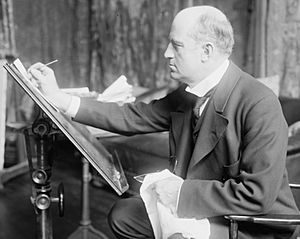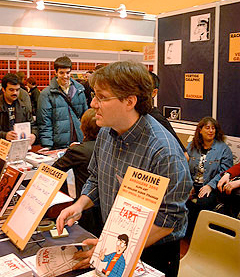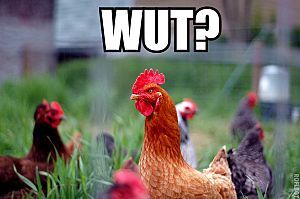Cartoonist facts for kids
A cartoonist (also comic strip creator) is a visual artist who specializes in drawing cartoons. This work is often created for entertainment, political commentary, or advertising. Cartoonists may work in many formats, such as animation, booklets, comic strips, comic books, editorial cartoons, graphic novels, manuals, gag cartoons, graphic design, illustrations, storyboards, posters, shirts, books, advertisements, greeting cards, magazines, newspapers, and video game packaging. Cartoons can be pictures on a printed page (also called comics or comic strips) or moving pictures on film (also called animation). Both kinds of cartoons can be found on the internet.
Contents
History
In the West
The English satirist and editorial cartoonist William Hogarth, who emerged In the 18th century, has been credited with pioneering Western sequential art. His work ranged from realistic portraiture to comic strip-like series of pictures called "modern moral subjects". Much of his work poked fun at contemporary politics and customs; illustrations in such style are often referred to as "Hogarthian". Following the work of Hogarth, political cartoons began to develop in England in the latter part of the 18th century under the direction of its great exponents, James Gillray and Thomas Rowlandson, both from London. Gillray explored the use of the medium for lampooning and caricature, calling the king (George III), prime ministers and generals to account, and has been referred to as the father of the political cartoon.
While never a professional cartoonist, Benjamin Franklin is credited with having the first cartoon published in an American newspaper. In the 19th century, professional cartoonists such as Thomas Nast introduced other familiar American political symbols, such as the Republican elephant.


During the 20th century, numerous magazines carried single-panel gag cartoons by such freelance cartoonists as Charles Addams, Irwin Caplan, Chon Day, Clyde Lamb, and John Norment. These were almost always published in black and white, although Collier's often carried cartoons in color. Single-panel cartoonists syndicated to newspapers included Dave Breger, Hank Ketcham, George Lichty, Fred Neher, Irving Phillips, and J. R. Williams.
Comics
Comic strips received widespread distribution to mainstream newspapers by syndicates such as the Universal Press Syndicate, United Media, or King Features. Sunday strips go to a coloring company such as American Color before they are published.
Some comic strip creators publish in the alternative press or on the Internet. Comic strip artists may also sometimes work in book-length form, creating graphic novels. Both vintage and current strips receive reprints in book collections.
The major comic book publishers (such as Marvel or DC) utilize teams of cartoonists to produce the art (typically separating pencil work, inking and lettering while the color is added digitally by colorists). When a consistent artistic style is wanted among different cartoonists (such as Archie Comics), character model sheets may be used as reference.
Calum MacKenzie, in his preface to the exhibition catalog, The Scottish Cartoonists (Glasgow Print Studio Gallery, 1979) defined the selection criteria:
- The difference between a cartoonist and an illustrator was the same as the difference between a comedian and a comedy actor—the former both deliver their own lines and take full responsibility for them, the latter could always hide behind the fact that it was not his entire creation.
Types of animation
Animated cartooning is created for short films, advertising, feature films and television. It is also sometimes used in live-action films for dream sequences or opening titles. An animation artist is commonly referred to as an animator rather than a cartoonist. They create motion pictures as well. Animation studios such as DreamWorks Animation, Pixar, Walt Disney Animation Studios, and Blue Sky Studios create CGI, or computer-animated films that are more three-dimensional.
There are many books of cartoons in both paperback and hardcover, such as the collections of cartoons from The New Yorker. Prior to the 1960s, cartoons were mostly ignored by museums and art galleries. In 1968, the cartoonist and comedian Roger Price opened the first New York City gallery devoted exclusively to cartoons, mainly work by the leading magazine gag cartoonists. Today, there are several museums devoted to cartoons, notably the Billy Ireland Cartoon Library & Museum, run by curator Jenny E. Robb at Ohio State University.
Creation
Comics artists usually sketch a drawing in pencil before going over the drawing in India ink, using either a dip pen or a brush. Artists may also use a lightbox to create the final image in ink. Some artists, Brian Bolland for example, use computer graphics, with the published work as the first physical appearance of the artwork. By many definitions (including McCloud's, above) the definition of comics extends to digital media such as webcomics and the mobile comic.
The nature of the comics work being created determines the number of people who work on its creation, with successful comic strips and comic books being produced through a studio system, in which an artist assembles a team of assistants to help create the work. However, works from independent companies, self-publishers, or those of a more personal nature can be produced by a single creator.
Within the comic book industry of North America, the studio system has come to be the main method of creation. Through its use by the industry, the roles have become heavily codified, and the managing of the studio has become the company's responsibility, with an editor discharging the management duties. The editor assembles a number of creators and oversees the work to publication.
Any number of people can assist in the creation of a comic book in this way, from a plotter, a breakdown artist, a penciller, an inker, a scripter, a letterer, and a colorist, with some roles being performed by the same person.
In contrast, a comic strip tends to be the work of a sole creator, usually termed a cartoonist. However, it is not unusual for a cartoonist to employ the studio method, particularly when a strip become successful. Mort Walker employed a studio, while Bill Watterson disliked the studio method, based on the influence of Charles Schulz, who also was in dislike of the studio method. preferring to create the strip himself. Gag, political, and editorial cartoonists tend to work alone as well, though a cartoonist may use assistants.
Art styles

While almost all comics art is in some sense abbreviated, and also while every artist who has produced comics work brings their own individual approach to bear, some broader art styles have been identified. Comic strip artists Cliff Sterrett, Frank King and Gus Arriola often used unusual, colorful backgrounds, sometimes veering into abstract art.
The basic styles have been identified as realistic and cartoony, with a huge middle ground for which R. Fiore has coined the phrase liberal. Fiore has also expressed distaste with the terms realistic and cartoony, preferring the terms literal and freestyle, respectively.
Scott McCloud has created "The Big Triangle" as a tool for thinking about comics art. He places the realistic representation in the bottom left corner, with iconic representation, or cartoony art, in the bottom right, and a third identifier, abstraction of image, at the apex of the triangle. This allows placement and grouping of artists by triangulation.
- The cartoony style uses comic effects and a variation of line widths for expression. Characters tend to have rounded, simplified anatomy. Noted exponents of this style are Carl Barks and Jeff Smith.
- The realistic style, also referred to as the adventure style is the one developed for use within the adventure strips of the 1930s. They required a less cartoony look, focusing more on realistic anatomy and shapes, and used the illustrations found in pulp magazines as a basis. This style became the basis of the superhero comic book style, since Joe Shuster and Jerry Siegel originally worked Superman up for publication as an adventure strip.
McCloud also notes that in several traditions, there is a tendency to have the main characters drawn rather simplistic and cartoony, while the backgrounds and environment are depicted realistically. Thus, he argues, the reader easily identifies with the characters, (as they are similar to one's idea of self), whilst being immersed into a world, that's three-dimensional and textured. Good examples of this phenomenon include Hergé's The Adventures of Tintin (in his "personal trademark" Ligne claire style), Will Eisner's Spirit and Osamu Tezuka's Buddha, among many others.
Tools
Artists use a variety of pencils, paper, typically Bristol board, and a waterproof ink. When inking, many artists preferred to use a Winsor & Newton Series 7, #3 brush as the main tool, which could be used in conjunction with other brushes, dip pens, a fountain pen, and/or a variety of technical pens or markers. Mechanical tints can be employed to add grey tone to an image. An artist might paint with acrylics, gouache, poster paints, or watercolors. Color can also be achieved through crayons, pastels or colored pencils.
Eraser, rulers, templates, set squares and a T-square assist in creating lines and shapes. A drawing table provides an angled work surface with lamps sometimes attached to the table. A light box allows an artist to trace his pencil work when inking, allowing for a looser finish. Knives and scalpels fill a variety of needs, including cutting board or scraping off mistakes. A cutting mat aids paper trimming. Process white is a thick opaque white material for covering mistakes. Adhesives and tapes help composite an image from different sources.
Famous Cartoonists
- Walt Disney (Mickey Mouse, Donald Duck)
- Terry Gilliam (Monty Python)
- Tex Avery (Looney Tunes,Droopy)
- Chuck Jones (Looney Tunes, How the Grinch Stole Christmas, Tom and Jerry)
- Don Martin (MAD Magazine)
- Bil Keane (Family Circus)
- Jim Davis (Garfield, U.S. Acres)
- Matt Groening (Life in Hell, The Simpsons, Futurama)
- Robert Crumb (Keep on Truckin')
- Al Capp (Lil' Abner)
- Hanna-Barbera (The Flintstones, Tom and Jerry, Scooby Doo)
- Max and Dave Fleschier (Koko The Clown, Betty Boop, Popeye)
- Gary Larson (Far Side)
- Mike Judge (Beavis and Butthead, King of the Hill)
- Chester Gould (Dick Tracy)
- Jay Ward (Rocky and Bullwinkle, George of the Jungle)
- Don Bluth (American Tail, Land Before Time)
- Bill Watterson (Calvin and Hobbes)
- Ub Iwerks (Mickey Mouse)
- Garry Trudeau (Doonsbury)
- Aaron McGruder (The Boondocks)
- Stan Lee (Marvel Comics)
- Charles Schulz (Peanuts)
- Sergio Aragonés (MAD Magazine, Groo the Wanderer)
- Dave Berg (MAD Magazine)
- John Kricfalusi (Ren and Stimpy, Ripping Friends)
- Mort Walker (Beetle Bailey)
- Scott Adams (Dilbert)
- Carl Barks (Scrooge McDuck)
- Peyo (The Smurfs)
- Bob Clampett (Looney Tunes, Beany and Cecil)
- Bob Kane (Batman, Coragous Cat and Minute Mouse, Cool McCool)
- Todd McFarlane (Spawn)
- Seth McFarlane (Family Guy, American Dad)
- Charles Addams (The Addams Family, New Yorker)
- Friz Freling (Looney Tunes)
See also
 In Spanish: Humorista gráfico para niños
In Spanish: Humorista gráfico para niños




